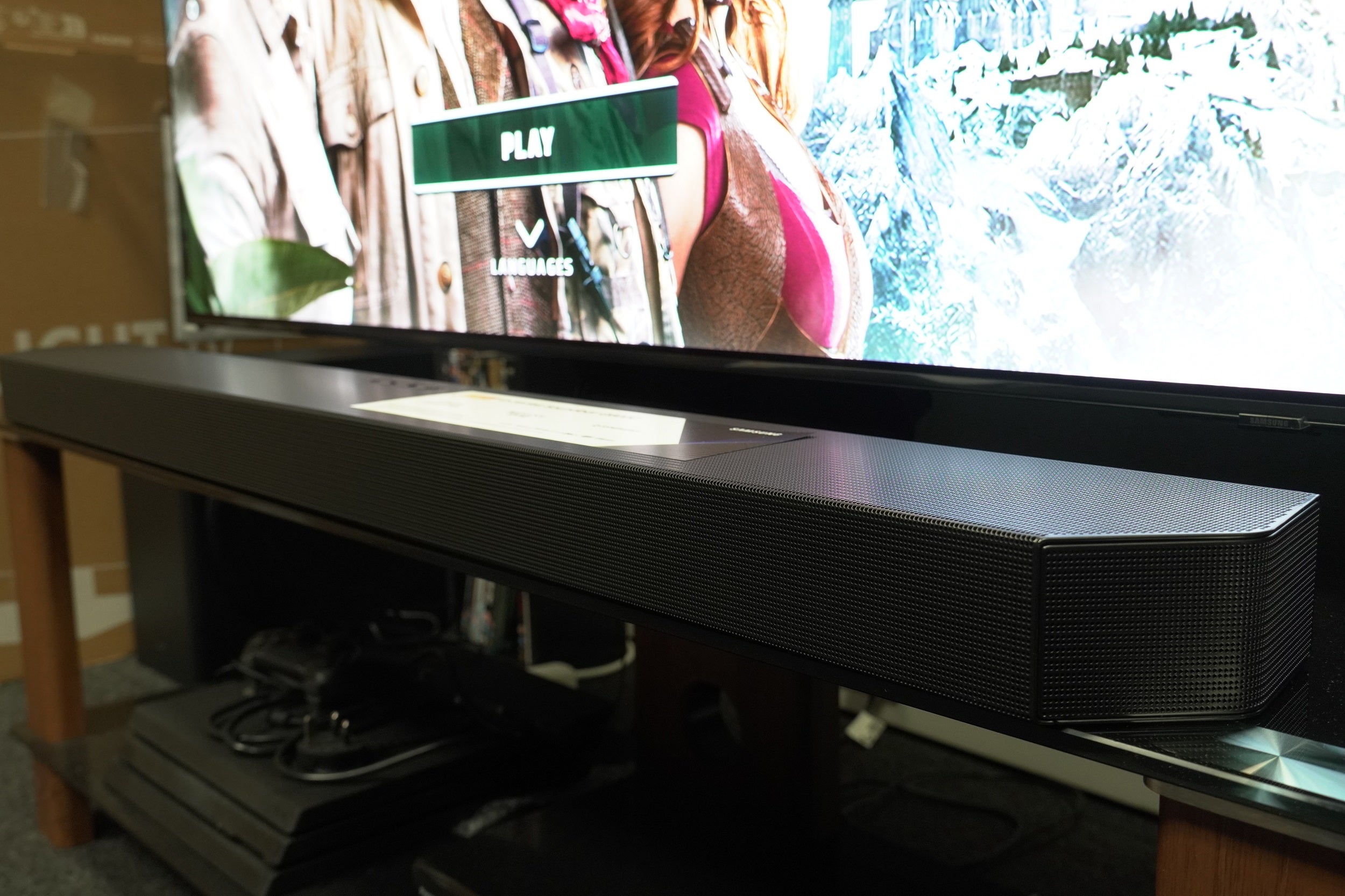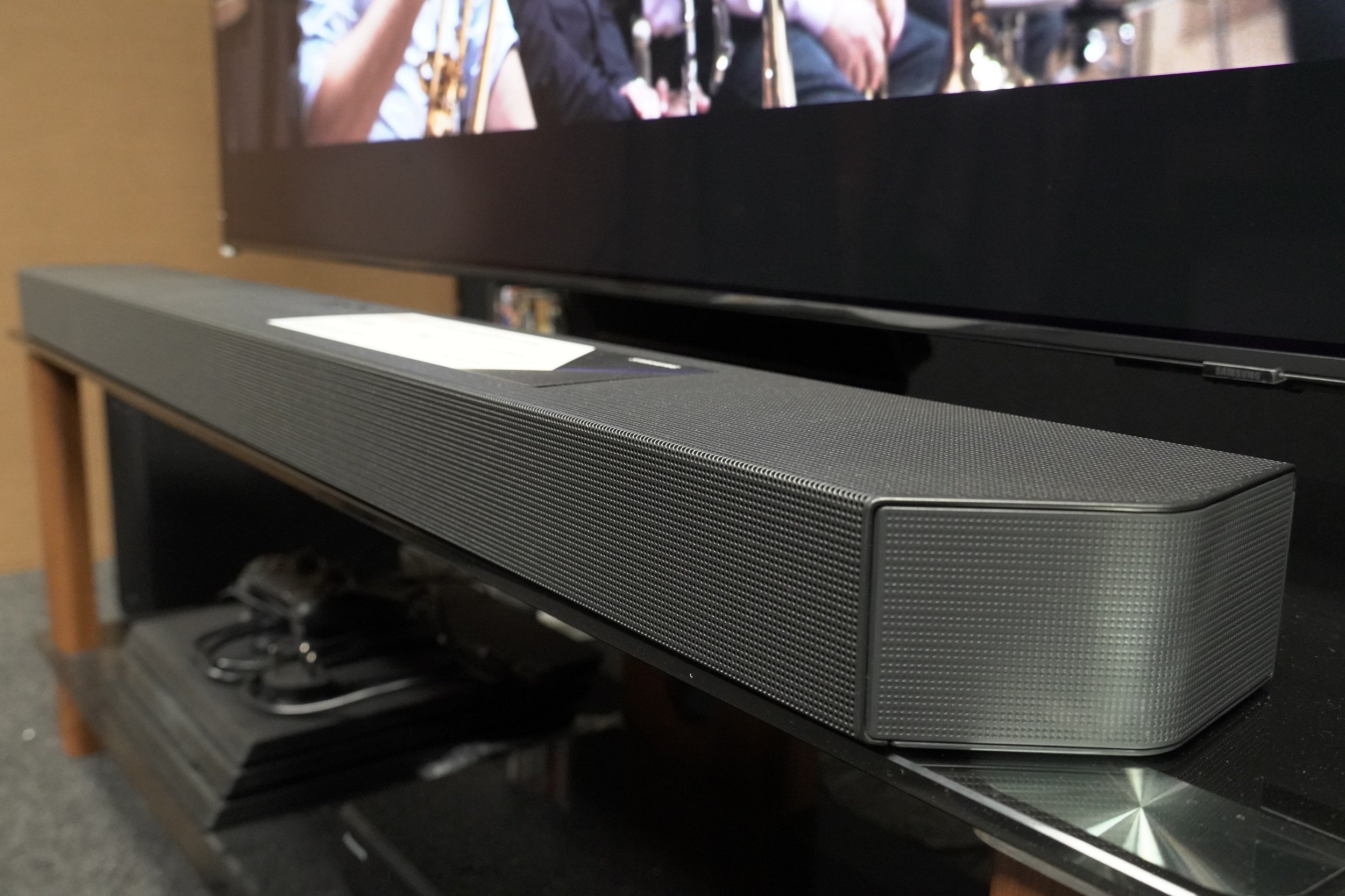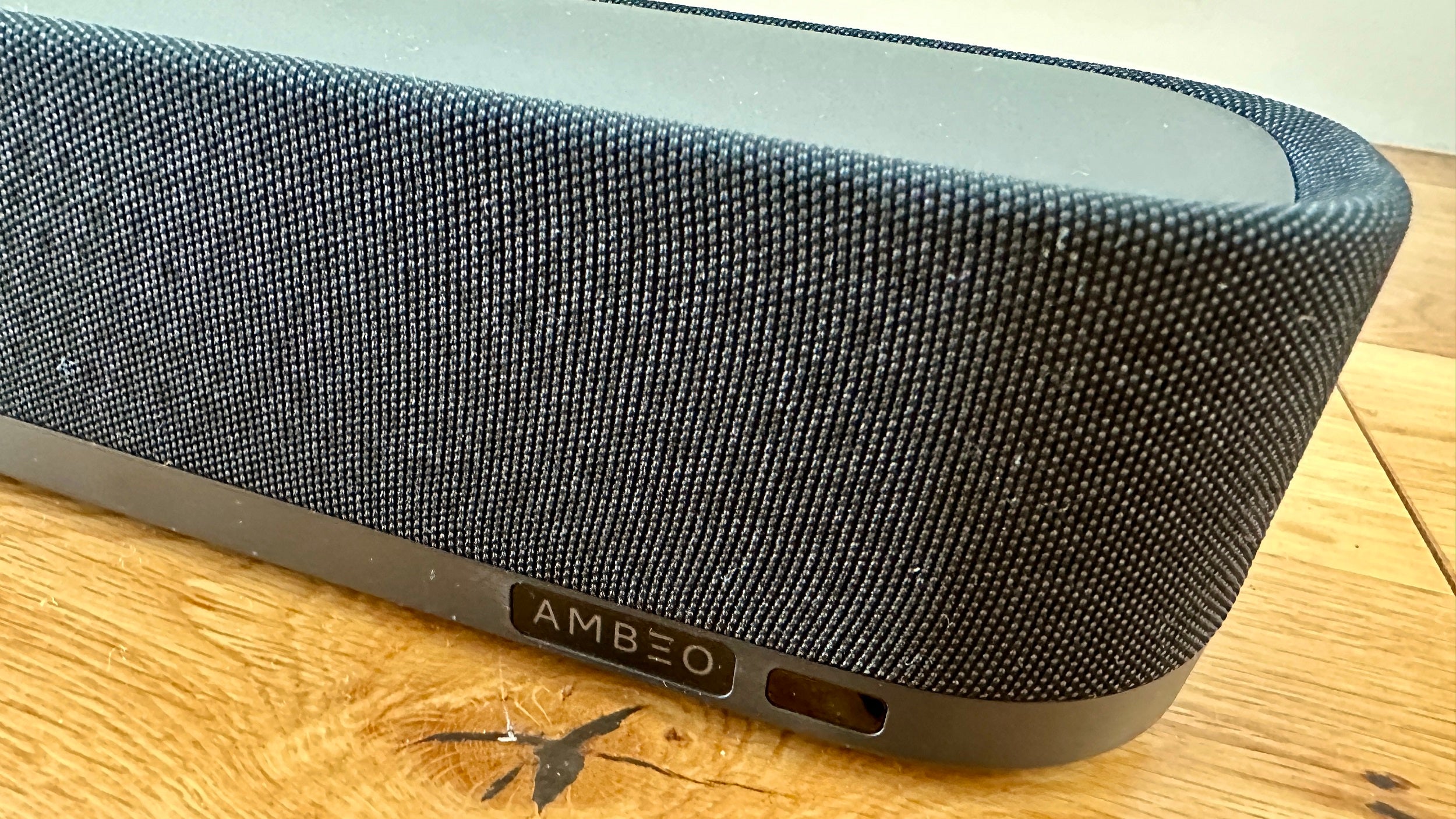Samsung HW-Q990C Review
Samsung’s latest and best soundbar system yet
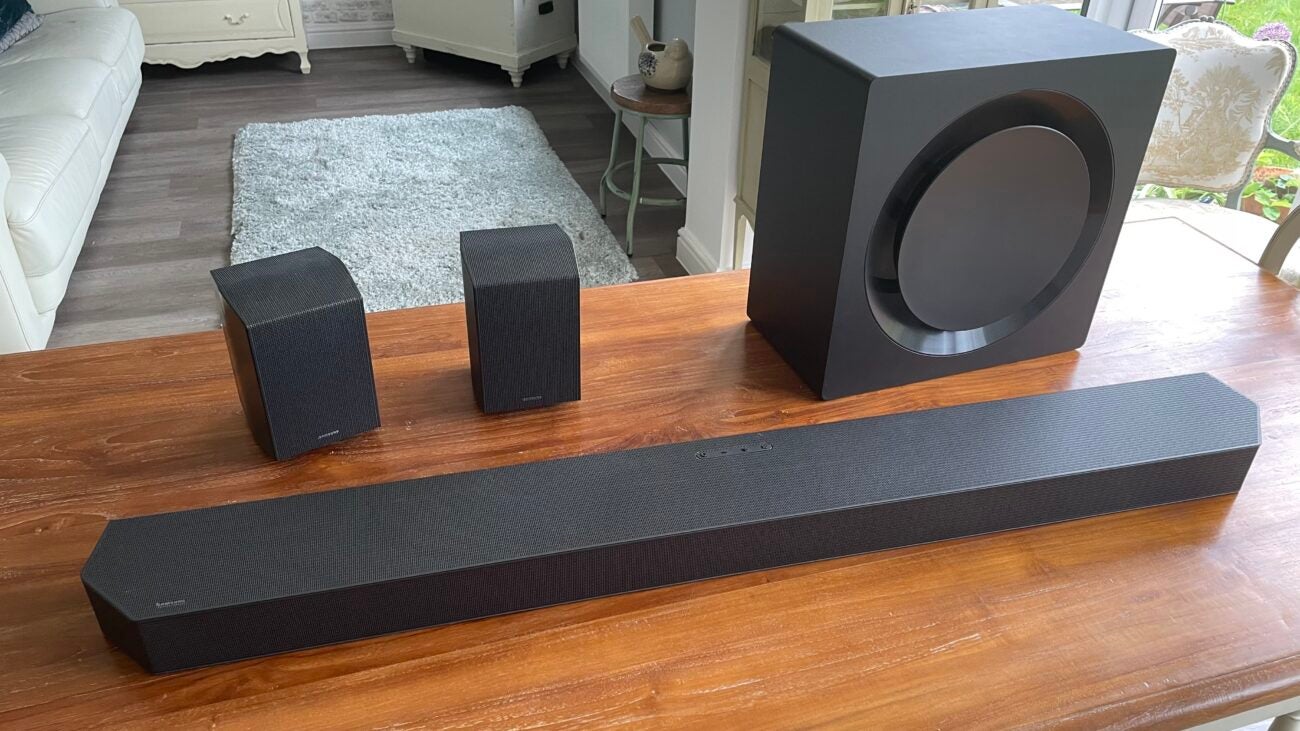

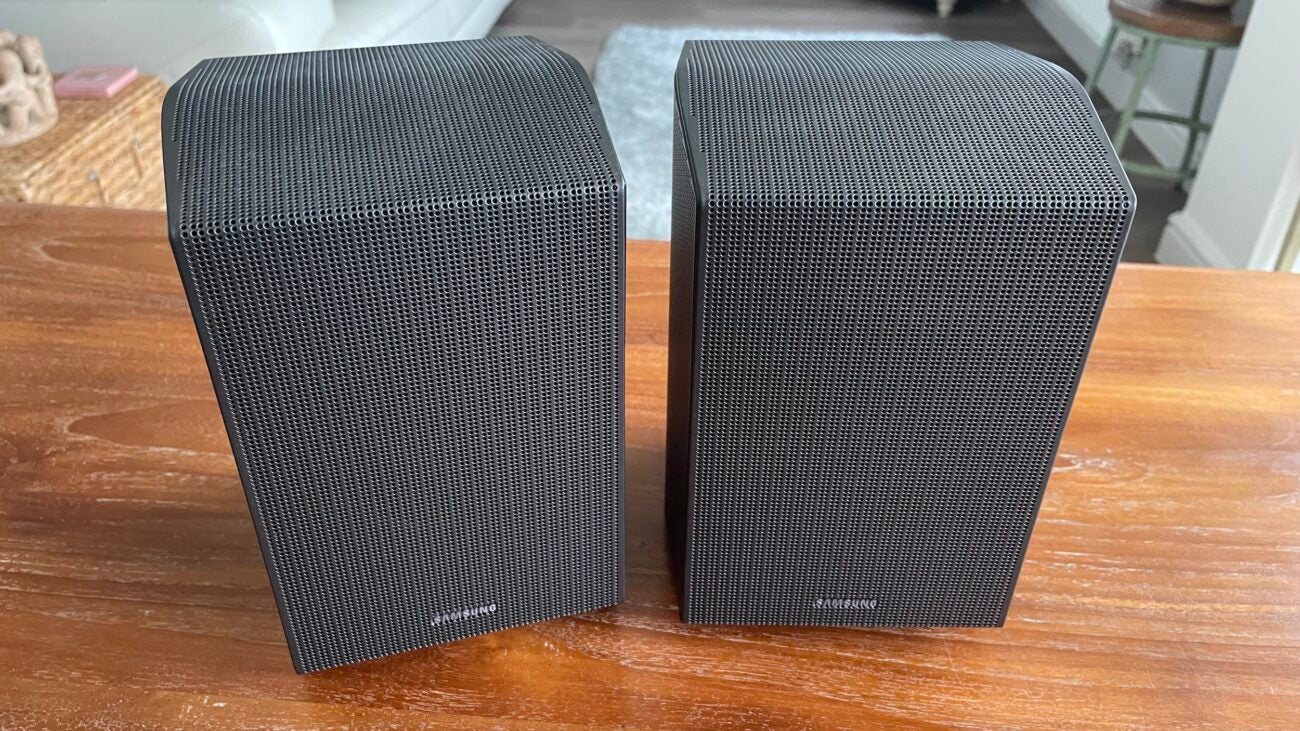


Verdict
Samsung’s latest flagship soundbar doesn’t exactly reinvent the wheel – but then it doesn’t need to. And at least what improvements it does make are in all the right places.
Pros
- Outstandingly powerful
- Peerless Dolby Atmos staging
- Dolby Vision and HDR10+ pass through
Cons
- Expensive for a soundbar
- No 4K/120Hz passthrough
- Subwoofer occasionally struggles with music
Key Features
- 11.1.4 channels16 channels of sound to create a full Dolby Atmos hemisphere
- Dolby Atmos and DTS:XBoth object-based movie sound formats are supported by the Q990C
- HDMI loop-through with Dolby Vision and HDR10+ supportDoesn’t need to rely on HDMI eARC to get Dolby Atmos to the bar
- Q SymphonyLets Samsung soundbars join forces with Samsung TV speakers for a bigger soundstage
- Power656W of total power across its 16 channels.
Introduction
The days of routine increases in channel counts for Samsung’s annual flagship soundbar refreshes are definitely over. Last year’s HW-Q990B stuck with the 11.1.4 channel count of its predecessor, and the 2023 Q990C retains the same 15-channel configuration too.
Though hitting pause on channel increases might have made it harder for Samsung to come up with easy marketing messages for itstop-end soundbars, the decision actually makes sense. After all, it’s not as if 11.1.4 channels isn’t a) more than you get just about anywhere else in the soundbar world, and b) easily enough to create a uniquely complete and immersive Dolby Atmos sound stage.
What’s more, in not relying on adding more channels seems to have given Samsung’s sound engineers more bandwidth to focus on improvements in other areas.
Availability
The HW-Q990C is on sale in the UK for £1,599 and in the US for $1,599.99.
Samsung’s step-down model, the HW-Q930C, loses a couple of channels, five drivers and the Acoustic Lens design for the subwoofer but at time of review was priced substantially less at £1,149 / $999.
Design
- Comprises four separate components
- Crisp, metallic finish
- HDMI loop through, with two HDMI inputs and eARC support
At first glance I thought the four-component HW-Q990C was identical to its Q990B predecessor. The main soundbar enjoys exactly the same dimensions and angular shape, as well as the same hard grilled finish; the two rear speakers feature the same distinctive mini plinth feet, unusual roof-shaped top edge and another metallic grilled finish.
The main subwoofer is also the same size, features the same 8-inch driver, and sports the same protruding Acoustic Lens cover over the driver to diffuse bass frequencies more smoothly and evenly.
Placing the Q990B and Q990C side-by-side did finally reveal one difference though: the HW-Q990C has a slightly lighter colour. Samsung describes the new tone as Titan Black, but in truth it looks more like dark grey.

Connectivity is the same. You get two HDMI inputs and a single, eARC HDMI output, alongside an optical audio input and the Wi-Fi and Bluetooth options I expect from pretty much any soundbar. The only disappointment is that the HDMI loop-through doesn’t support 4K/120Hz feeds from the latest games consoles and PC cards – something the LG S95QR does support, to an extent.
At least the HDMI can pass-through Dolby Vision and HDR10+ HDR formats. It continues to be rare to find a soundbar that supports both these HDR formats.
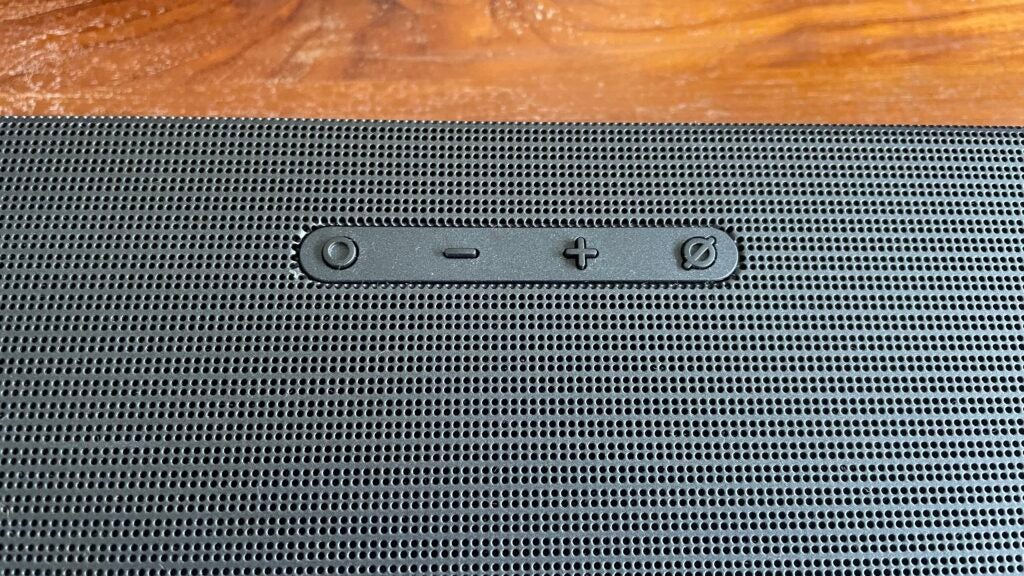
The top edge of the main soundbar features a row of control buttons, while the front edge carries a small but bright and very legible LED display to keep tabs on volume levels, selected input, sound preset options, source formats and so on. Mercifully, Samsung has not reverted to its old practice of placing the LED display on the top edge, where you could only see it if you were standing up.
The HW-Q990C ships with a slim, nicely finished remote control that features a reasonably logical and responsive array of buttons. You can also control the Q990C using Samsung’s SmartThings app if you’d prefer a more visual interface.
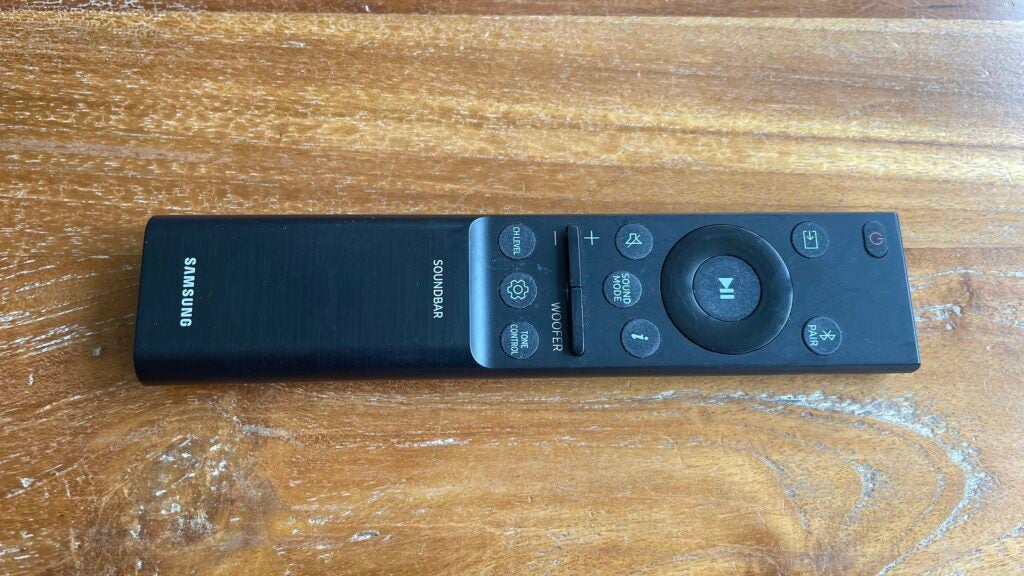
Features
- Dolby Atmos and DTS:X playback
- 656W total power across 11.1.4 channels
- Auto calibration system
With no obvious physical or speaker configuration differences to speak of bar the slight colour variation, it requires a deeper dive to find out what the HW-Q990C offers that we haven’t seen from a Samsung soundbar before.
The first thing to catch my eye is the addition of the SmartThings Hub to the soundbar’s SmartThings app control options, enabling control over other compatible devices networked around the home. While this is an interesting development in the connected home world that’s big in the South Korean and Japanese markets, I don’t think it’s a particularly big deal for most UK or US soundbar buyers.

More universally useful is the addition of built-in support for the Amazon Alexa – especially as the Alexa support extends to being able to group supported devices in multi-room set ups. The Q990C also works with Apple AirPlay if you have a compatible device.
Also good to find given Samsung’s previous reticence in this area is a newly enhanced version of its SpaceFit Sound Pro auto-calibration system. The main change is that it now sensibly brings the subwoofer’s bass contribution into the main sound auto-optimisation process, rather than bass calibration being controlled by a separate system.
Samsung’s Adaptive Sound mode has been upgraded too. This apparently does a better job of identifying and maintaining the clarity of object sounds – including voices – at low volume levels. If this works as promised it would address one of the few negatives of Samsung’s previous flagship soundbars – though hopefully it won’t compromise Samsung’s reputation for its soundbars delivering legendary amounts of power and dynamism.
The HW-Q990C gets the third generation of Samsung’s Q Symphony feature, too. This system for sharing the speakers in the soundbar with those in compatible Samsung TVs now uses every speaker in both the TV and soundbar when the two are working together, as well as enabling the soundbar to use the audio processor in the latest Samsung TVs for superior audio analysis.
While much of this new stuff – especially the improved auto-calibration tools – is welcome, it’s still the features continued on from the Q990B that give the Q990C star appeal.
These start with that monster 11.1.4 channel count that comprises of one side-firing channel in each rear speaker, two up-firing channels in the main soundbar, an up-firing driver in each rear speaker, front drivers in each rear speaker, the ‘.1’ subwoofer bass channel, plus centre, front left, front right, side left, side right, front side left and front side right channels tucked into the Q990C’s surprisingly compact main soundbar.
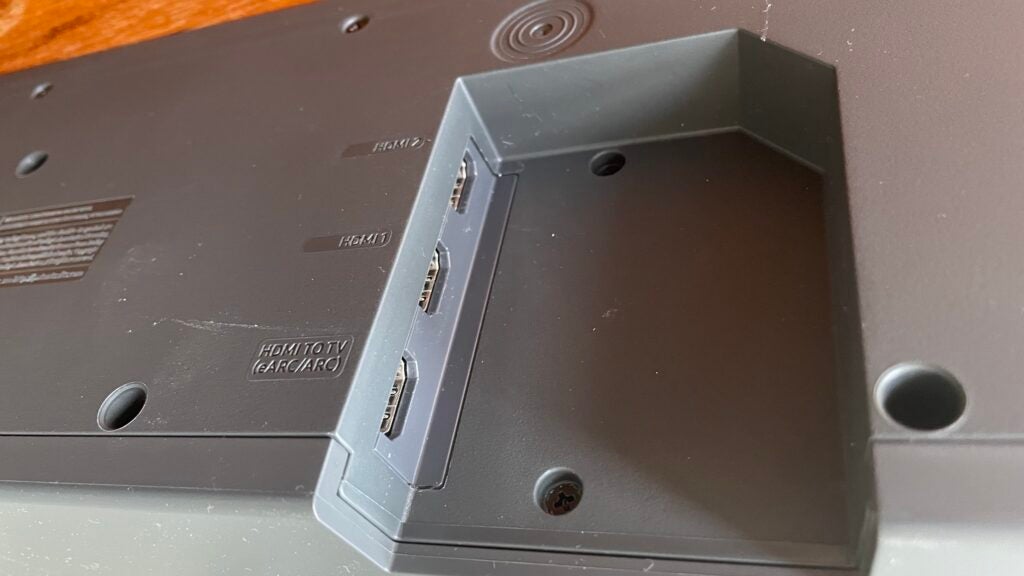
Then there’s the point of all these channels: to create that full hemisphere of an immersive three-dimensional bubble around the viewer that’s integral to a convincing Dolby Atmos or DTS:X experience. Having gone to such lengths to create such a fulsome Dolby Atmos/DTS:X soundstage, it is a relief to find the Q990C supports both formats via either its HDMI loop-through, or HDMI 2.1 standard’s audio return channel (ARC/eARC) feature.
The HW-Q990C carries an Active Voice Amplifier option that scans your room for ambient noise, such as a vacuum cleaner, and increases the clarity of vocals in the mix when it deems necessary. Plus there’s a Game Mode that exaggerates the directionality of sound to more clearly detect where enemies might be shooting from.
As you’d expect of a flagship soundbar, the Q990C rounds its appeal out with a good selection of music sources that includes Airplay 2, Spotify Connect, Tap Sound (where tapping a recent Samsung Galaxy phone against the bodywork automatically establishes a wireless connection), LPCM multi channel support, and playback of Hi-Res audio, AAC, WAV, FLAC, AIFF, MP3, OGG and ALAC music files. [Editors note: it was previously mentioned that Chromecast was supported. We’ve been told by Samsung that’s an error in the specification].
Sound Quality
- Large scale, dynamic performance
- Cohesive, balance soundstage
- Hits high volumes without distortion
Before getting into how the HW-Q990C sounds, it’s worth mentioning that it’s very easy to set up thanks to the way all the four speakers detect and connect with each other without fuss. The SmartThings app makes it easy to get the soundbar on your Wi-Fi network and perform any firmware updates.
I did experience a couple of occasions where the SmartThings app on my iPhone suddenly lost connection, and wouldn’t re-establish unless I unplugged, rebooted the soundbar and re-ran the Add Device option in the app.
With film soundtracks the Q990C sounds pretty much identical to the Q990B. That’s no bad thing given the Q990B has been the best full-surround Dolby Atmos soundbar I’ve heard until the Q990C’s arrival.
The power and dynamism of the HW-Q990C’s movie sound is a particular highlight. No other soundbar delivers action scenes with as much intensity, impact and bite, and its dynamic range is enormous.
The subwoofer continues to deliver some of if not the deepest rumbles in the soundbar world. Its Acoustic Lens set up ensures bass hardly ever bottoms out (sound compressed at very low frequencies), and consistently sounds more well-rounded and smooth than Samsung’s non-Acoustic Lens soundbar subwoofers.
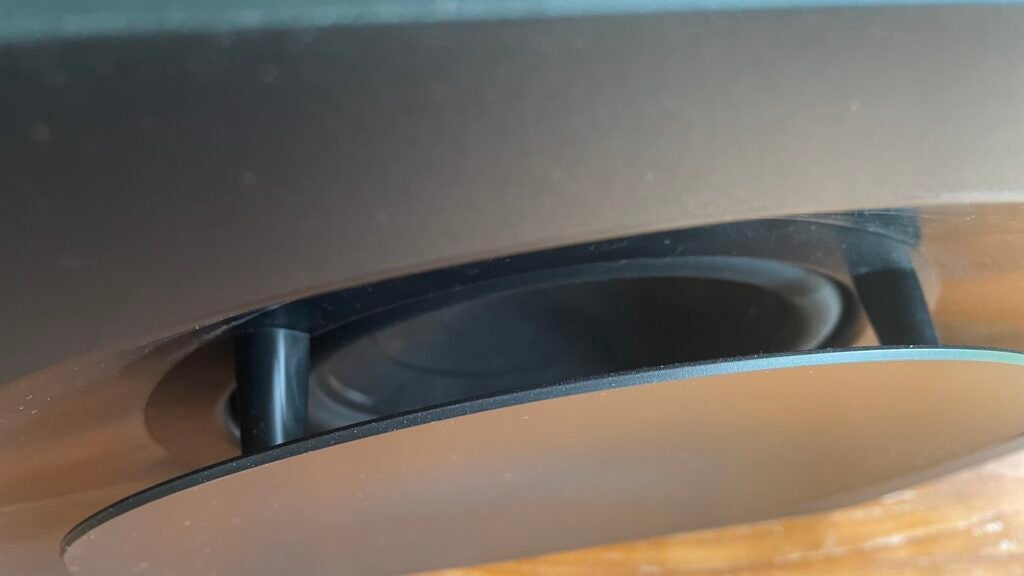
The subwoofer also sounds impressively responsive and nimble. In fact, with the SpaceFit Pro auto calibration feature in play, the subwoofer provides the biggest area of improvement over the Q990B – especially when responding more effectively to the changing gears of a bass-heavy scene.
The rest of the Q990C’s soundstage is outstandingly cohesive and balanced. Especially, once SpaceFit has been called into action. The rears and height channels are fantastically detailed and eager to be involved, contributing to the most fully formed Atmos soundstage currently available in the soundbar world. Having a more sympathetically integrated subwoofer to underpin the cohesion of all the other channels is just the icing on the cake.
The scale of the Q990C’s sound is immense, filling a large living room from side-to-side, front to back and floor to ceiling. There’s nothing vague about this huge sound stage, either. Atmos and DTS:X mixes enjoy an immaculately coherent and perfectly formed ‘dome’ of sound within which I could detect no noticeable gaps.
I’m aware of every single channel in the system, but only in an immersive way; no channel feels under- or over-powered enough to draw specific attention to itself.
Specific placement effects in Dolby Atmos and DTS:X mixes are positioned with unique accuracy, and this accuracy extends to pretty much flawless transitions of sounds around the soundstage – be they overhead, to left and right, or from front to back.
The clarity extends to dialogue, which always sounds clear, natural and contextualised as well as being slightly lifted so that voices come from the onscreen action than from the speaker.
The HW-Q990C handles shrill, peak trebles as well as it handles the deepest bass elements, avoiding harshness, hissing, over-emphasis or warbling even with the most high-pitched movie sounds I could find.
As I’ve come to expect with Samsung’s high-end soundbars, the volume levels the Q990C can reach without a hint of distortion are immense. There are only a handful of rivals that can get close – and even those can’t do so while also delivering the full Atmos soundstage precision that the Q990C gives you.
Considering how precise its soundstage sounds, the HW-Q990C is surprisingly forgiving of placement in different types of room set up (for example, the centre of a wall, or in a corner with the rear speakers positioned at an angle behind). The sound still manages to sound symmetrical, and the Dolby Atmos dome of sound still feels complete and convincing. My presumpton is this sort of room layout flexibility owes much to the effectiveness of the latest SpaceFit system.
Focusing on another of the Q990C’s claimed improvements, its latest Adaptive Sound mode does as promised by retaining a better balance at low volumes than the Q990B. Details retain more presence, helping to make the low-volume soundstage seem busier and more involving. It actually feels like the speakers are more sensitive – an impressive feat to achieve through a processing tweak.

The final element of the Q990C’s movie performance I tried out (with a Samsung QN900C 8K TV) was its Q-Symphony system. I was pleasantly surprised to find the TV’s speakers matching well with the soundbar, at least up to moderate volumes, resulting in some welcome extra verticality to the front soundstage. Voices and centre-channel effects have more spatial precision as a result, and the front soundstage feels more solid – more like a wall of sound.
The mismatch between the capabilities of the TV and soundbar speakers can start to become a slight issue at high volumes, but overall the new version of Q Symphony is impressively sophisticated.
Samsung soundbars have traditionally struggled to moderate their epic quality with movies to deliver a similarly stellar music performance. The focus on muscle has tended to be too strong. Things started to improve with the Q990B, at least in the way its Adaptive mode remixed basic stereo tracks to take advantage of all the system’s speakers. And now the musicality of Samsung soundbars has improved again – provided you’re careful where you place the subwoofer.
With the subwoofer placed off to the side of my sofa as usual and playing music in its default stereo format, it felt as if the Q990C’s performance with music was broadly in line with the Q990B. It stages songs fairly well and delivers them with levels of power and dynamic range far beyond most regular hi-fi systems.
Detail levels are high without sounding forced too, and vocals are exceptionally clear. Vocals often, especially with female singers, enjoy a pleasingly soaring feel.
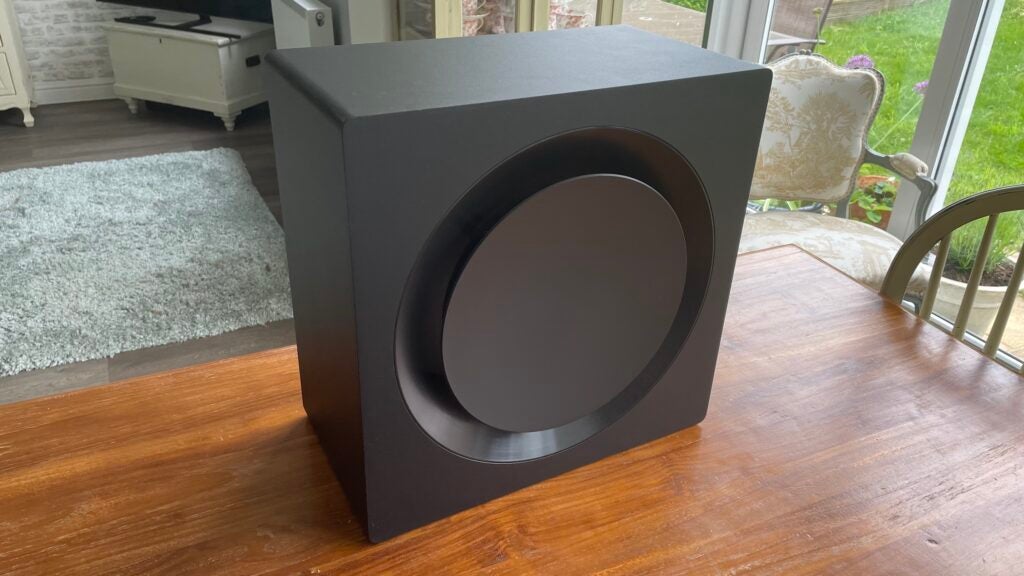
On the downside, dense, multi-track music can sound a little muddy and overly dense – albeit slightly less so than with the Q990B thanks to the improved bass management.
As with the Q990B, with the sub in my default position, the HW-Q990C makes music pretty interesting with its Adaptive mode, thanks to the way it reduces that sense of excessive density I mentioned earlier and proves very clever about the way it pushes different elements of a stereo mix to different channels. In fact, the results sometimes really sound like original Dolby Atmos studio mixes (complete with surprisingly effective overhead vocal steering on occasion).
The Q990C’s tweaked Adaptive mode also ensures that music remains more lively and detailed at relatively low volumes than it has tended to on previous Samsung soundbar flagships.
The Adaptive mode doesn’t always sound totally right. Its separation effects can come on a little too strong, making the mix suddenly sound a bit forced and artificial. Also, occasionally the Adaptive mode’s faith in the Q990C’s rear speakers can be too optimistic, feeding them elements of a mix that are too much for their drivers to handle.
Overall, though, I often found myself preferring to listen to music in the Q990C’s Adaptive mode than Standard stereo. Or at least that was the case until I moved the subwoofer so it was positioned nearer the main soundbar, in front of my seating position, and let the SpaceFit Pro do its work again.
In this configuration, bass sounds more responsive and better balanced with the rest of a stereo mix than it did with the subwoofer placed in its more distant position, immediately making it easier to become immersed in a stereo track.
It almost feels as if placing the subwoofer in this different spot causes an adjustment to the soundbar’s crossover point. Whether or not that’s the case, there’sno doubt the difference with the subwoofer positioned in a forward position is palpable, and makes the HW-Q990C easily the most musical Samsung flagship soundbar I’ve ever heard with stereo music. The Q990C can be considered a genuine all-rounder – even if its prowess over its rivals remains at its most pronounced with film soundtracks.
Latest deals
Should you buy it?
You want a full surround sound system: The HW-Q990C provides not only physical rear speakers, but rear speakers with side- and up-firing channels that meet up with similar speakers built into the main soundbar to deliver a fantastically immersive and full dome of Dolby Atmos sound.
You want 4K/120Hz pass through: Sadly the HDMI pass through system on the HW-Q990C can’t cope with the 4K/120Hz graphics feeds you can now get from Xbox Series X, PS5s and high-end PC graphics cards.
Final Thoughts
Despite the Samsung HW-Q990C not boasting any significant hardware changes over its 2022 predecessor (unless a slight colour change floats your boat), it still manages to introduce small but significant improvements.
The new auto calibration system improves bass handling with both music and movie sources, new music tuning enhances stereo playback (if you put the subwoofer in the right place), and the latest version of Samsung’s new Q-Symphony system joins forces more effectively with the speakers in Samsung TVs than it has before.
While the Q990C’s improvements over its predecessor may be relatively minor compared with previous giant steps, they are are being made to a soundbar that was already quite comfortably the most powerful, immersive and complete-sounding Dolby Atmos soundbar in town. So in essence, the HW-Q990C is simply the best made better.
How we test
We test every soundbar system we review thoroughly over an extended period of time. We use industry standard tests to compare features properly. We’ll always tell you what we find. We never, ever, accept money to review a product.
Find out more about how we test in our ethics policy.
Tested with real world use
Tested for more than a week
FAQs
16, delivered in an 11.1.4 configuration (the .1 being the bass channel, and the .4 referring to four up-firing channels to deliver height effects.
Yes, both can be enjoyed via the HDMI loop through or via your TV using eARC provided your TV has the necessary eARC and sound format support.
This is a feature that enables Samsung soundbars to join forces with Samsung TVs, drawing on the audio processing power of the TVs and getting the speakers in the TV to work alongside those in the soundbar for a larger sound stage.


